
|
|
The fully programmable HP 8116A Pulse/Function Generator features both capabilities in one small unit. A broad 1 mHz-50 MHz band for all waveforms and a wide choice of operating and modulating modes assure high flexibility. In normal mode, the HP 8116A's auto-vernier increments any desired parameter continuously until a stop signal is applied. This means that thresholds can be measured automatically, without a controller. For applications such as laser diodes or dc motors, square waves can be programmed for constant duty cycles from 10% to 90%. For digital test, or for simulating very low duty-cycle events, pulse width can be programmed down to 10 ns. Square wave and Pulse modes provide clean 6 ns edges that are ideal for many technologies. Pulse width modulation and pulse recovery capability are available in Pulse mode. For Sine and Triangle Functions; 10% to 90% duty cycle, programmable in 1 % steps, provides ramps and asymmetrical sine waves for testing VCO's, servos, amplifier linearity and industrial process control systems. Haverfunctions, available in External Trigger, Gate and Burst modes, extend the applications to areas such as telephone line and vibration testing. All waveforms can be amplitude or frequency modulated. VCO operation allows frequency variation over two decades with an external voltage; consequently transducer output can be conditioned for mag tape recording, or frequency-shift keying or linear sweep can be carried out. Specifications. Frequency Range: 1 mHz to 50 MHz (3-digit resolution). Sine, triangle, square, haverfunctions and dc, 1 mHz-50 MHz, 32 Vpp for all waveforms, Variable (10 ns min) pulse width, 6 ns transitions, Range: 10.0 mVpp to 16.0 Vpp (3-digit resolution), Digital display. Opt. 001: Burst and Logarithmic Sweep.
|